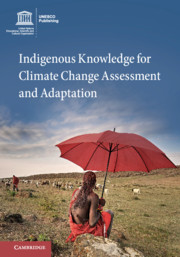Book contents
- Indigenous Knowledge for Climate Change Assessment and Adaptation
- Indigenous Knowledge for Climate Change Assessment and Adaptation
- Copyright page
- Contents
- Contributors
- Foreword
- Acknowledgements
- Abbreviations
- 1 Indigenous Knowledge for Climate Change Assessment and Adaptation: Introduction
- Part I Knowing our Weather and Climate
- Part II Our Changing Homelands
- Part III Confronting Extreme Events
- 12 Accounts from Tribal Elders: Increasing Vulnerability of the Navajo People to Drought and Climate Change in the Southwestern United States
- 13 The Spirits Are Leaving: Adaptation and the Indigenous Peoples of the Caribbean Coast of Nicaragua
- 14 Indigenous Reindeer Herding and Adaptation to New Hazards in the Arctic
- 15 ‘Everything That Is Happening Now Is Beyond Our Capacity’ – Nyangatom Livelihoods Under Threat
- Part IV Sources of Indigenous Strength and Resilience
- Index
- References
14 - Indigenous Reindeer Herding and Adaptation to New Hazards in the Arctic
from Part III - Confronting Extreme Events
Published online by Cambridge University Press: 13 September 2018
- Indigenous Knowledge for Climate Change Assessment and Adaptation
- Indigenous Knowledge for Climate Change Assessment and Adaptation
- Copyright page
- Contents
- Contributors
- Foreword
- Acknowledgements
- Abbreviations
- 1 Indigenous Knowledge for Climate Change Assessment and Adaptation: Introduction
- Part I Knowing our Weather and Climate
- Part II Our Changing Homelands
- Part III Confronting Extreme Events
- 12 Accounts from Tribal Elders: Increasing Vulnerability of the Navajo People to Drought and Climate Change in the Southwestern United States
- 13 The Spirits Are Leaving: Adaptation and the Indigenous Peoples of the Caribbean Coast of Nicaragua
- 14 Indigenous Reindeer Herding and Adaptation to New Hazards in the Arctic
- 15 ‘Everything That Is Happening Now Is Beyond Our Capacity’ – Nyangatom Livelihoods Under Threat
- Part IV Sources of Indigenous Strength and Resilience
- Index
- References
- Type
- Chapter
- Information
- Publisher: Cambridge University PressPrint publication year: 2018
References
- 4
- Cited by



